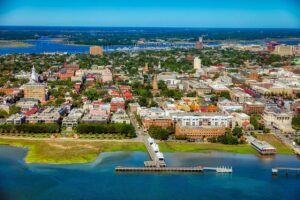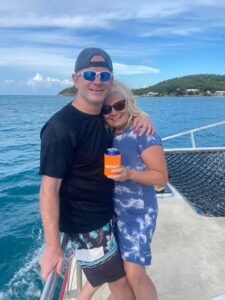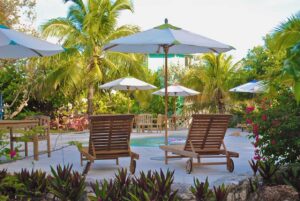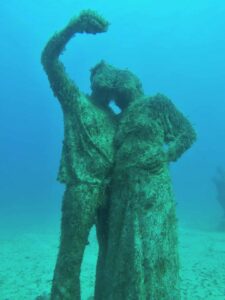Ask any Looper, “What is your favorite memory of the Great Loop?” and the answer will undoubtedly be, “The people.”
This would ring true as we continued our journey up the Hudson River in mid-June. The staff members at the Hudson River Maritime Museum in Kingston, N.Y., were part of that special group of people who left an indelible impression on our memories. They even helped arrange day trips to explore the nearby U.S. Military Academy at West Point, the Roosevelt home at Hyde Park, a local apple orchard and the village of Woodstock.
At the town of Waterford, N.Y., the gateway to the Erie Canal, open arms and friendly smiles greeted us wherever we went. Upon departing several days later, we wondered if residents realized how hard it was for us to leave their hospitality. But we had read Bernstein’s “Wedding of the Waters” years ago and were very excited to begin this particular part of our journey. Having a more in-depth historical perspective of this waterway helped make the trip even more meaningful.
Turning off the Erie Canal and onto the Oswego Canal, we decided to stay overnight at the lock in Phoenix, N.Y. Greeted by their famous “Bridgehouse Brats,” these young envoys of the N.Y. State Canal System ranged in age from 8 to 18. They merrily ran errands for boaters and tended the grounds at the Lock 1 Bridgehouse Museum under the watchful eyes of senior volunteers.
A daylight journey across Lake Ontario from Oswego, N.Y., landed us in another town named Kingston, only this one was in Ontario, Canada. The town’s unique European-style architecture and snippets of French conversations between passers-by reminded us that we were actually in a foreign country.
Traveling west from Kingston, we stopped at another gateway city: Trenton. This would be the first step of our “climb” through Canada’s Trent-Severn Waterway, a spectacular 240-mile long canal route that links Lake Ontario to Lake Huron. Lockmasters seemingly competed with one another to paint their canvasses of lush green lawns with the most brilliant assortment of floral colors. The unmatched uniqueness and impressive beauty of this meandering waterway is one of the prime reasons Loopers reminisce long after completing e Great Loop.
Upon reaching the waterway’s end at Port Severn, we caught our breath and prepared for the next portion of our journey: Georgian Bay. These pristine waters are another reason Canada left a lofty impression on us. Part of Lake Huron but located entirely in Ontario, the bay is a mixture of sandy beaches, pine forests and rugged bedrock. Well-marked but sparsely inhabited, it’s hard to describe the feeling that washed over us while navigating between granite boulders and the skinny little PVC pipes that the Park Service use as channel markers.
At the northwest end of Georgian Bay, beyond Killarney, we ducked into the sheltered waters behind Manitoulin Island and into North Channel. Stunning natural beauty ran continuously along the rugged shoreline, hiding countless secluded anchorages from which to observe the majestic bald eagles that soared overhead. We never knew such a marvelous boating paradise existed! Fortunately, Canada’s “gone too fast” summer provided sublime weather for the duration of our cruise.
The pros and cons of cruising down Lake Michigan’s eastern shore versus western shore have been, and will be, forever debated amongst Loopers. Once again, it was the people we met along our journey down the eastern shore of the lake that helped make it an unforgettable experience. Locals often offered to drive us to get provisions, pick up boat parts, see local historic sites, or even to visit the best hairdresser in town! We found ourselves never wanting to leave any of the charming towns we visited: Mackinac Island, Petoskey, Leland, Frankfort, Ludington, White Lake, Grand Haven, South Haven, St. Joseph, Michigan City.
Whoever told us Chicago’s DuSable Harbor Marina was a convenient location was absolutely correct! We arrived after Labor Day weekend and were able to walk almost everywhere: Millennium Park, “The Bean,” the theater District, Soldier Field, Chicago Riverwalk. The nearby metro train easily transported us to Wrigley Field, home of the Chicago Cubs. A boat ride on the Chicago River Architectural Tour was a fabulous way to view the downtown buildings and learn about the history of this great city.
Sadly leaving Lake Michigan behind, we carefully headed south through the city’s busy shipping channel, which lead Spiritus to the Illinois River. After spending a leisurely five days on the Illinois cruising by towns like Joliet, Ottawa, Peoria and Havana, we eventually reached the muddy Mississippi River.
The mystique of the mighty Mississippi causes concern amongst Loopers who have heard “tales” told by those who have gone before them. An overnight stop at Hoppie’s Marina, downstream of St. Louis, for a thorough briefing of what to expect, what to do and where to anchor helped reduce the anxiety held by most of us.
We made good time as the Mississippi’s current pushed us downstream at a higher-than-normal cruising speed. But with the good comes the bad. Eventually we turned up the Ohio River and our speed was quickly cut in half.
Green Turtle Bay Marina, just beyond the Barkley Lock on the Cumberland River, was an outstanding place to rest, resupply, refuel and rejoin our fellow Loopers. It was fun to share our newly acquired memories with folks who truly understand the uniqueness of this journey. After several days respite, some of us continued up the Cumberland to visit Nashville, the Music City! Others continue to spend time enjoying the solitude of splendid anchorages found in the Kentucky Lake region of the Tennessee River. We all looked forward to connecting again in October at the annual AGLCA Rendezvous at Alabama’s Joe Wheeler State Park Lodge.
Almost everyone who completes the Great Loop will tell you that they cherish the lifelong friendships they made during their trip along America’s waterways. And the lucky ones will happily brag that they did the entire year in shorts!





